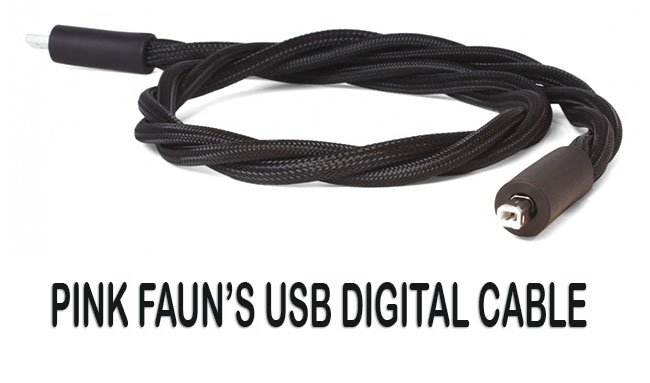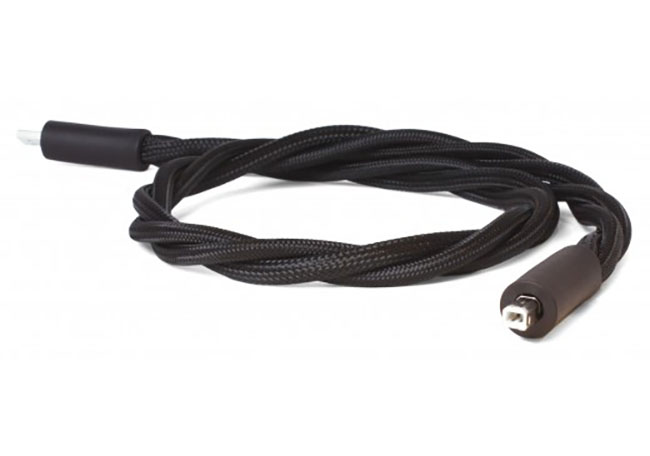Pink Faun USB Digital Cable by Mike Wright
 The summer of 2020 was a period of growth for me as an audiophile, music lover, and writer. There was a lot to learn, and I asked manufacturers whose wares I was reviewing many questions. The person that I had the most compelling discussions with has to be Brian Zolner of Bricasti Design. Part of this was driven from the standpoint of not just plugging a Bricasti DAC into my system but making sure I was aware of its capabilities and getting the best performance. The other aspect of our discussions surrounded networking or my lack of knowledge of how networking worked. We would exchange texts and emails until late into the evening, and I figured I had to have been driving him crazy with the questions.
The summer of 2020 was a period of growth for me as an audiophile, music lover, and writer. There was a lot to learn, and I asked manufacturers whose wares I was reviewing many questions. The person that I had the most compelling discussions with has to be Brian Zolner of Bricasti Design. Part of this was driven from the standpoint of not just plugging a Bricasti DAC into my system but making sure I was aware of its capabilities and getting the best performance. The other aspect of our discussions surrounded networking or my lack of knowledge of how networking worked. We would exchange texts and emails until late into the evening, and I figured I had to have been driving him crazy with the questions.
Brian Zolner was always patient and helpful.
One of the things Zolner told me that stuck with me was that he was not a fan of computer-based audio being listened to through a USB cable. This information was a little hard for me to digest because enough audiophiles, including me, were doing just that. Brian challenged me to get over my preconceived notions and listen and let him know what I heard. And you know, he was right. Most of the USB digital cables I listened to have an edge to them that you could hardly say sounded like analog, which is what we all try to achieve. You know, “digital to analog” converters which a lot of us audiophile types have. Initially, I hardly noticed it, figuring it was just an artifact of having a quieter signal coming from a computer via a USB cable. What could be so wrong with that? We use computers every day. Soon, I found that Brian’s trains of thought were correct. I soon concluded that I needed to find a better digital cable.
I read up on all the ads, reviews, and chatroom discussions on AudiogoN and even had discussions about USB digital cables with my friends. I must say, I listened to many excellent sounding systems, but those discussions with Brian stuck with me all the while. I had to take this to the next level. I decided to write to some cable manufacturers regarding their digital cables; as expected, most referred me to their websites. This was also okay because unless I had their cable in my system, explanations and pictures wouldn’t have answered my questions concerning performance. One European manufacturer promptly recommended I contact their US distributor, who tried to sell me an expensive Stealth digital cable. I had an interesting encounter with a company with a good reputation, but I had never heard of or knew anything about their products.
The name stood out for some reason, though. This company was called Pink Faun. A peculiar sounding name, I thought. According to the dictionary, a “faun” is a mythological half human-half goat, being from Greek mythology as a symbol of peace and fertility. Well, well, well. That’s alright. About an hour or two, after I sent them an email requesting information regarding their USB digital cable, I heard back from Jord Groen, the owner of Pink Faun. Now, this was more like it. Groen was accommodating to my questions and even offered a USB digital cable for review. I was on reviewer “cloud nine” after that. How could I refuse?
Technically speaking
 Pink Faun is a high-end digital manufacturer specializing in network streamers, such as their 2.16, 2.16 X, and 2.16 Ultra, as well as various types of digital cables and AC cords. Their USB digital, under review here, appeared to be very well made and is distinctive by what appears to be three twisted strands of cable.
Pink Faun is a high-end digital manufacturer specializing in network streamers, such as their 2.16, 2.16 X, and 2.16 Ultra, as well as various types of digital cables and AC cords. Their USB digital, under review here, appeared to be very well made and is distinctive by what appears to be three twisted strands of cable.
There is not much technical information on their website. When I attempted to get more technical information, Groen was more interested in the review, letting readers know how the cable sounds. An evaluation seemed to be what Pink Faun was most excited about; how their product performs sonically.
I was not going to press the matter any further than I had to, so I’ll share with you what I was able to get from the Pink Faun website:
“The Pink Faun Digital Cable Series are all made by hand by our own craftsmen. Each digital cable is designed for its specific task. All of these fully handmade cables have one very important feature in common: they are made with our in-house developed, non-inductive tin-plated copper conductors, extruded through a framework of ultra-low dielectric fabrics and PTFE tubing. During the design of the Pink Faun Digital cables, we approach digital as an analogue signal that’s interpreted as 1 or 0 by the sender and receiver. The Digital Cable Series are all designed to minimize the influence of the cable while transporting the digital signal. Our cables are very neutral, without any harshness or coloration. If you are looking for tight, fast and rhythmic digital interlinks, the Pink Faun Digital series will deliver: No Sound, Just Music!”
How It Sounds
Most of these sonic impressions are of the Pink Faun after it’s gone through the recommended break-in period. Initially, my thoughts on the sound of Pink Faun’s USB digital cable were that it was positively organic and analog, especially compared to most USB digital cables I have evaluated. The improvements over what I had been hearing were slight but definitely could be heard.
 All vestiges of that slight bit of “digititis” that I would hear using my other USB digital cables were not there, at least not at levels that I could hear them or were not prevalent. Initially, I wondered if things had gotten softer, but they hadn’t. Not at all. When I play music, references that I use for transient response, such as Mason Bates’ Stereo is King [Innova], tracks “Stereo Is King” and “Terrycloth Troposphere.” Or Joel Grare’s Paris – Istanbul – Shanghai [Alpha], tracks “Nihavent,” “La femme de l’eau” and “Au Coronet d’Amour,” that simply was not the case. This sound was very smooth and very detailed, but at the same time, layered, with a wide, deep stage. So much more of the detail and musical information in those digital streams and CDs were now more alive and natural. The Pink Faun’s high frequencies were airy and extended without any of those little digital sonic vagaries previously heard. With the Pink Faun in the system, they sounded authentic when cymbals and triangles were struck; the decay was natural. Gone was that low-level noise.
All vestiges of that slight bit of “digititis” that I would hear using my other USB digital cables were not there, at least not at levels that I could hear them or were not prevalent. Initially, I wondered if things had gotten softer, but they hadn’t. Not at all. When I play music, references that I use for transient response, such as Mason Bates’ Stereo is King [Innova], tracks “Stereo Is King” and “Terrycloth Troposphere.” Or Joel Grare’s Paris – Istanbul – Shanghai [Alpha], tracks “Nihavent,” “La femme de l’eau” and “Au Coronet d’Amour,” that simply was not the case. This sound was very smooth and very detailed, but at the same time, layered, with a wide, deep stage. So much more of the detail and musical information in those digital streams and CDs were now more alive and natural. The Pink Faun’s high frequencies were airy and extended without any of those little digital sonic vagaries previously heard. With the Pink Faun in the system, they sounded authentic when cymbals and triangles were struck; the decay was natural. Gone was that low-level noise.
 Along with this increased upper extremity performance came a quieter midrange. Vocals sounded purer and true, and performers sounded more in the room with that “reach out and touch” feel. The Pink Faun’s performance with dynamics is excellent, and its low-end performance is exceptional. Next, I listened to the CD La Bamba [Klavier] by the O-Zone Percussion Group, Gary Olmstead, Director. Tracks like “Highlife” and “Jazz Variants” will give you the flavor of what the Pink Faun is like handling percussive slam, dynamics, and transients. Amber Rubarth’s recording, Session’s From The 17th Ward [Chesky], is another example of the Pink Faun’s exceptional handling of image placement and detail retrieval. There are a lot of sounds coming from the recorded environment and ambiance that you hear throughout your soundstage due to Chesky’s use of the binaural recording technique. Which seemingly places the listener in the room with the instrumentalists. The placement of all of the performers was locked in across the stage. On tracks such as “Tundra,” “Strive,” and “Novocaine,” there are subtle, low-level events you can hear (e.g., the traffic/car horns outside the venue) during quiet passages, as well as cellist Dave Eggar’s breathing technique being easier to follow and the notes from the violin and cello decay into the room was excellent.
Along with this increased upper extremity performance came a quieter midrange. Vocals sounded purer and true, and performers sounded more in the room with that “reach out and touch” feel. The Pink Faun’s performance with dynamics is excellent, and its low-end performance is exceptional. Next, I listened to the CD La Bamba [Klavier] by the O-Zone Percussion Group, Gary Olmstead, Director. Tracks like “Highlife” and “Jazz Variants” will give you the flavor of what the Pink Faun is like handling percussive slam, dynamics, and transients. Amber Rubarth’s recording, Session’s From The 17th Ward [Chesky], is another example of the Pink Faun’s exceptional handling of image placement and detail retrieval. There are a lot of sounds coming from the recorded environment and ambiance that you hear throughout your soundstage due to Chesky’s use of the binaural recording technique. Which seemingly places the listener in the room with the instrumentalists. The placement of all of the performers was locked in across the stage. On tracks such as “Tundra,” “Strive,” and “Novocaine,” there are subtle, low-level events you can hear (e.g., the traffic/car horns outside the venue) during quiet passages, as well as cellist Dave Eggar’s breathing technique being easier to follow and the notes from the violin and cello decay into the room was excellent.
For female vocals, I returned to Lizz Wright’s D reaming Wide Awake [Verve]. I love Ms. Wright’s warm, rich vocal tone, which the Pink Faun handles with aplomb. My go-to track on this recording is “A Taste of Honey.” Ms. Wright sings this selection with a mellow, reflective timbre, but the musicians also add a lot to this track. This group of performers includes guitarist Chris Bruce, bassist David Piltch, drummer Earl Harvin, and Glenn Patscha on keyboards, making this a delightful recording.
reaming Wide Awake [Verve]. I love Ms. Wright’s warm, rich vocal tone, which the Pink Faun handles with aplomb. My go-to track on this recording is “A Taste of Honey.” Ms. Wright sings this selection with a mellow, reflective timbre, but the musicians also add a lot to this track. This group of performers includes guitarist Chris Bruce, bassist David Piltch, drummer Earl Harvin, and Glenn Patscha on keyboards, making this a delightful recording.
A Word About That Break-In Period
I’m humming along, admiring the Pink Faun’s build and design, when Jord lets me know to pay particular attention to cable break-in. He said his cable needs a serious 500 hours. Initially, my jaw hit the floor. I don’t mind doing a break-in that long and far, be it from me to argue with the manufacturer. But frankly, I was already getting good results with the Pink Faun even though I only had about 50 hours on it. But I thought back to when I had to go through a nearly 500-hour break-in process to get my Holo Audio May Kitsune DAC’s performance optimal. It was worth it and made me believe in break-in (component or cable). After a little over a week of breaking in the Pink Faun, I reached the 120-hour mark in the break-in process. It was then that I started to listen to music again. I don’t know what it was, but things began to click with the Pink Faun. Musically, things came to life even more. I had a level of detail, high-frequency extension, air, and, above all, musicality that had somehow improved. Over the next few weeks, incrementally, detail increased, and the tonal color with which the music spoke became more incremental and more vibrant. I was getting so much more of everything from the Pink Faun. And yet, even after 120 hours, the burn-in period was not complete. After I surpassed the 400-hour mark, the level of musical involvement started to increase noticeably, and by the time I made the 500-hour mark, I was utterly impressed with the improvement the Pink Faun had brought to my system.
Does the Pink Faun need 500 hours of break-in? In my opinion, yes! Reaching that 120-hour mark was a revelation as you begin to get a glimpse of what the cable can do. But go through the break-in process as the manufacturer recommends. The cable will reward you at the end of the journey.
 Another point to make; Christiaan Punter, in his excellent Pink Faun review for HiFi-Advice, commented on how he had unplugged the Pink Faun to either listen to something else or to move a piece of gear, and when he went back to the Pink Faun, his sound changed. I did that same thing, doing my due diligence by plugging in and unplugging other USB cables for comparison’s sake. Suffice it to say, once I returned to the Pink Faun, there was much gnashing of teeth for that first hour before it came back sonically. I concluded he was not overstating the truth.
Another point to make; Christiaan Punter, in his excellent Pink Faun review for HiFi-Advice, commented on how he had unplugged the Pink Faun to either listen to something else or to move a piece of gear, and when he went back to the Pink Faun, his sound changed. I did that same thing, doing my due diligence by plugging in and unplugging other USB cables for comparison’s sake. Suffice it to say, once I returned to the Pink Faun, there was much gnashing of teeth for that first hour before it came back sonically. I concluded he was not overstating the truth.
Conclusion
USB digital cables have come a long way, in terms of performance, in the last few years. Is it from isolating the ground? I don’t know. I’m not technically astute enough to be able to say for sure. There are some nice-sounding USB digital cables out there that I have heard. Curious Cable’s Evolved, Computer Audio Design’s USB1, Final Touch Audio’s Callisto, and Nordost’s Tyr2 all sounded exceptional and left me feeling like these cable design guys aren’t just looking at digital cables as something to throw on a USB connector. Instead, they are using their talents and energy to put some serious thought into their designs. I feel the Pink Faun USB digital cable is one of the finest available for under $900. Not cheap. But its performance may allow it to be considered a bargain for the enhancement it can bring to your system. Just don’t forget about the break-in period. For you folks more inclined to all things technical, I’ve included Pink Faun’s contact info at the end of this review. You should find them accommodating to your questions as I was.


mike wright
Pink Faun USB Digital Cable – 750 Euros (about USD 890.00)
Address:
Van Deventerstraat 10
3911KH Rhenen (UT)
The Netherlands
Phone: +31 (0) 85 112 4375
WhatsApp: +31 (0) 628455761
Email: jord@pinkfaun.com
Website: www.pinkfaun.com
Mike’s Associated Equipment:
Speakers
Tekton Design Moabs
Amplifier
VAC Signature 200 iQ Amplifiers (used as stereo and mono amps)
BSC Audio BSC100m 100-Watt Mono-amps
Preamplifier
VAC Renaissance Mk V with Phono
Analog
Merrill Heirloom Turntable
Rowland Research Consonance Tonearm
Transfiguration Phoenix Cartridge
Digital
Asus Laptop w/Fidelizer Pro, Roon, and JRiver v.26 for Hi-Res Files
Holo May Kitsune III DAC
Bricasti M5
Marantz SA-7S1 CD Player
Cables
Dynamic Design Heritage Balanced Interconnect
Dynamic Design PAAPI
Silversmith Fidelium Speaker Cable
Pink Faun USB
AnnaLyric Power Cords
Essential Sound Product Essence II Power Cords
Power Line Conditioner
Inakustik 3500P (Distributor loan)
Essential Sound Products Essence Power Distributor
Accessories
Star Sound Apprentice & Rhythm Platforms – for amps
Star Sound Sistrum Rhythm Two Platform Stand
Symposium Acoustics Ultra Platform
Symposium Acoustics HDSE Rollerblocks
Symposium Acoustics +2 Rollerblocks
Adona GX4 Equipment Stand
Epiphany Stand Systems – Celeste Reference Stand
Stereo Times Masthead
Publisher/Founder
Clement Perry
Editor
Dave Thomas
Senior Editors
Frank Alles, Mike Girardi, Russell Lichter, Terry London, Moreno Mitchell, Paul Szabady, Bill Wells, Mike Wright, and Stephen Yan,
Current Contributors
David Abramson, Tim Barrall, Dave Allison, Ron Cook, Lewis Dardick, John Hoffman, Dan Secula, Don Shaulis, Greg Simmons, Eric Teh, Greg Voth, Richard Willie, Ed Van Winkle, Rob Dockery, Richard Doron, and Daveed Turek
Site Management Clement Perry
Ad Designer: Martin Perry









Be the first to comment on: Pink Faun USB Digital Cable by Mike Wright